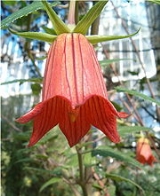
Canarina
Encyclopedia
Canarina is a genus
of flowering plants within the family
Campanulaceae
. The best known species is C. canariensis from the laurel forest
s of the Canary Islands
which is sometimes grown as an ornamental plant. Canarina canariensis is one of a group of unrelated Canarian plants that appear to be adapted for bird pollination, including the members of the genera Isoplexis
and Lotus
. It was once thought that the original pollinators of these plants were sunbirds which had become extinct on the Canary Islands, explaining why some of these species are rare and considered endangered (Vogel 1954; Vogel et al. 1984; Olesen 1985; Valido et al. 2004). However more recent work has shown that these plants are adequately pollinated by non-specialist flower visiting birds, particularly the Canary Island chiffchaff
(Phylloscopus canariensis) and the Canary Island Spectacled Warbler (Sylvia conspicillata orbitalis) (Olesen 1985; Ollerton et al. 2008), and in fact show some specific adaptations to infrequent pollination by these birds, such as extended flower lifespans (Ollerton et al. 2008), and a hexose-dominated sugar ratio of the nectar (Dupont et al. 2004).
Species
include:
Genus
In biology, a genus is a low-level taxonomic rank used in the biological classification of living and fossil organisms, which is an example of definition by genus and differentia...
of flowering plants within the family
Family (biology)
In biological classification, family is* a taxonomic rank. Other well-known ranks are life, domain, kingdom, phylum, class, order, genus, and species, with family fitting between order and genus. As for the other well-known ranks, there is the option of an immediately lower rank, indicated by the...
Campanulaceae
Campanulaceae
The family Campanulaceae , of the order Asterales, contains about 2000 species in 70 genera of herbaceous plants, shrubs, and rarely small trees, often with milky non-toxic sap...
. The best known species is C. canariensis from the laurel forest
Laurel forest
Laurel forest is a subtropical or mild temperate forest, found in areas with high humidity and relatively stable and mild temperatures. They are characterized by tree species with evergreen, glossy, enlongated leaves, known as laurophyll or lauroide...
s of the Canary Islands
Canary Islands
The Canary Islands , also known as the Canaries , is a Spanish archipelago located just off the northwest coast of mainland Africa, 100 km west of the border between Morocco and the Western Sahara. The Canaries are a Spanish autonomous community and an outermost region of the European Union...
which is sometimes grown as an ornamental plant. Canarina canariensis is one of a group of unrelated Canarian plants that appear to be adapted for bird pollination, including the members of the genera Isoplexis
Isoplexis
Isoplexis is a section of 4 species within the genus Digitalis. The species of section Isoplexis differ from other plants in the genus Digitalis in that their monosymmetric flowers have a distinctive large upper lip rather than large lower lip and the species are endemic to the Canary Islands...
and Lotus
Lotus (genus)
Lotus is a genus that includes bird's-foot trefoils and deervetches and contains many dozens of species distributed world-wide. Depending on the taxonomic authority, roughly between 70 and 150 are accepted. Lotus is a genus of legume and its members are adapted to a wide range of habitats, from...
. It was once thought that the original pollinators of these plants were sunbirds which had become extinct on the Canary Islands, explaining why some of these species are rare and considered endangered (Vogel 1954; Vogel et al. 1984; Olesen 1985; Valido et al. 2004). However more recent work has shown that these plants are adequately pollinated by non-specialist flower visiting birds, particularly the Canary Island chiffchaff
Chiffchaff
The Common Chiffchaff, or simply the Chiffchaff, is a common and widespread leaf-warbler which breeds in open woodlands throughout northern and temperate Europe and Asia....
(Phylloscopus canariensis) and the Canary Island Spectacled Warbler (Sylvia conspicillata orbitalis) (Olesen 1985; Ollerton et al. 2008), and in fact show some specific adaptations to infrequent pollination by these birds, such as extended flower lifespans (Ollerton et al. 2008), and a hexose-dominated sugar ratio of the nectar (Dupont et al. 2004).
Species
Species
In biology, a species is one of the basic units of biological classification and a taxonomic rank. A species is often defined as a group of organisms capable of interbreeding and producing fertile offspring. While in many cases this definition is adequate, more precise or differing measures are...
include:
- Canarina abyssinica Engl., which is native to EthiopiaEthiopiaEthiopia , officially known as the Federal Democratic Republic of Ethiopia, is a country located in the Horn of Africa. It is the second-most populous nation in Africa, with over 82 million inhabitants, and the tenth-largest by area, occupying 1,100,000 km2...
- Canarina canariensis (L.) Vatke (Canary Island Bellflower) which is native to the Canary IslandsCanary IslandsThe Canary Islands , also known as the Canaries , is a Spanish archipelago located just off the northwest coast of mainland Africa, 100 km west of the border between Morocco and the Western Sahara. The Canaries are a Spanish autonomous community and an outermost region of the European Union...
- Canarina eminii Asch. ex Schweinf., which is native to tropical areas in East AfricaEast AfricaEast Africa or Eastern Africa is the easterly region of the African continent, variably defined by geography or geopolitics. In the UN scheme of geographic regions, 19 territories constitute Eastern Africa:...
.

